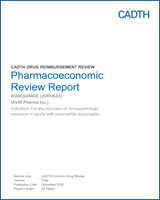The CADTH clinical review findings indicate that budesonide 1 mg is effective for inducing clinicopathologic remission in patients with active eosinophilic esophagitis (EoE) after six weeks of treatment, though the results are more pronounced for clinicohistologic remission than for the symptomatic remission component. The CADTH clinical review also noted uncertainty in the meaningfulness of the observed improvement in health-related quality of life. No information was available on the comparative effectiveness of budesonide 1 mg with treatments that are currently used for EoE in Canada.
Due to structural limitations with the sponsor’s model, CADTH was unable to estimate the cost-effectiveness of budesonide 1 mg over a relevant time horizon or compared with relevant comparators currently used for the treatment of EoE in Canada. CADTH was also unable to estimate the cost-effectiveness of budesonide 1 mg in the full population represented by the Health Canada indication, as there is a gap in evidence for patients with EoE who have not been shown to be refractory to proton pump inhibitors (PPIs). Furthermore, the identified limitations also highlighted that the sponsor’s model is inadequate to estimate the cost-effectiveness of budesonide 1 mg over the submitted one-year time horizon.
In order to provide some economic information, CADTH estimated the cost-effectiveness of budesonide 1 mg compared with no treatment over a single treatment and assessment period for an EoE flare (considered to range from six to 12 weeks). Based on a time horizon of 12 weeks, with a maximum duration of therapy of six weeks, budesonide 1 mg was associated with an incremental cost-effectiveness ratio (ICER) of $24,422 per quality-adjusted life-year (QALY) compared with no treatment. If a shorter time horizon (six weeks) or an increased maximum duration of budesonide 1 mg treatment (12 weeks) is considered, the ICER increases to $74,129 per QALY and $31,133 per QALY, respectively. The cost-effectiveness of budesonide 1 mg compared with other therapies used in the treatment of EoE in Canada over any time horizon is unknown.
At the submitted price, the drug acquisition cost of budesonide 1 mg orodispersible tablets is $462 for a six-week course of therapy, which is more expensive than other pharmacological therapies currently in use in Canada for the treatment of EoE.
Funding: CADTH receives funding from Canada’s federal, provincial, and territorial governments, with the exception of Quebec.
Disclaimer: The information in this document is intended to help Canadian health care decision-makers, health care professionals, health systems leaders, and policy-makers make well-informed decisions and thereby improve the quality of health care services. While patients and others may access this document, the document is made available for informational purposes only and no representations or warranties are made with respect to its fitness for any particular purpose. The information in this document should not be used as a substitute for professional medical advice or as a substitute for the application of clinical judgment in respect of the care of a particular patient or other professional judgment in any decision-making process. The Canadian Agency for Drugs and Technologies in Health (CADTH) does not endorse any information, drugs, therapies, treatments, products, processes, or services.
While care has been taken to ensure that the information prepared by CADTH in this document is accurate, complete, and up-to-date as at the applicable date the material was first published by CADTH, CADTH does not make any guarantees to that effect. CADTH does not guarantee and is not responsible for the quality, currency, propriety, accuracy, or reasonableness of any statements, information, or conclusions contained in any third-party materials used in preparing this document. The views and opinions of third parties published in this document do not necessarily state or reflect those of CADTH.
CADTH is not responsible for any errors, omissions, injury, loss, or damage arising from or relating to the use (or misuse) of any information, statements, or conclusions contained in or implied by the contents of this document or any of the source materials.
This document may contain links to third-party websites. CADTH does not have control over the content of such sites. Use of third-party sites is governed by the third-party website owners’ own terms and conditions set out for such sites. CADTH does not make any guarantee with respect to any information contained on such third-party sites and CADTH is not responsible for any injury, loss, or damage suffered as a result of using such third-party sites. CADTH has no responsibility for the collection, use, and disclosure of personal information by third-party sites.
Subject to the aforementioned limitations, the views expressed herein are those of CADTH and do not necessarily represent the views of Canada’s federal, provincial, or territorial governments or any third-party supplier of information.
This document is prepared and intended for use in the context of the Canadian health care system. The use of this document outside of Canada is done so at the user’s own risk.
This disclaimer and any questions or matters of any nature arising from or relating to the content or use (or misuse) of this document will be governed by and interpreted in accordance with the laws of the Province of Ontario and the laws of Canada applicable therein, and all proceedings shall be subject to the exclusive jurisdiction of the courts of the Province of Ontario, Canada.

